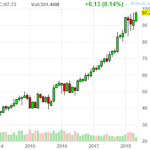Can a company have a $750 Billion market cap and still be under the radar? Microsoft seems to be just that. With all the talk of the FAANG stocks, you don’t hear as much about MSFT, Mister Softee. All they have done is continued to grow, continued to leverage their domination of computer operating systems, and continued to adapt to the changing software marketplace. Perhaps they have had a few mistakes along the way, but Microsoft is a true success story and one that hasn’t been written about as much in recent months.

Nadella
The above chart is a monthly chart of MSFT from about February 2014, when Satya Nadella became CEO, until now. MSFT has risen from about $38 to about $98 during that time, a 158% increase. Nadella has led the transformation of MSFT’s mission from “a PC on every desk” to “empower every person and every organization on the planet to do more” – a much larger mission. While retaining its dominance in PC operating systems (Windows and Office), MSFT has grown in several areas, including:
- Cloud computing;
- Gaming (XBox)
- Social Networks (acquisition of LinkedIn); and
- Artificial Intelligence.
MSFT has always been an acquisitive company and it remains so today. It is recently acquired or is in the process of acquiring several AI companies. “Hitting on all drivers”; “Poised to double cloud revenue by 2022”; “$1 Trillion Market Cap by 2021” – these are some of the quotes from recent Wall Street analyst reports on MSFT. As well as the stock has performed, perhaps it is poised to perform even better in the ensuing years. With a diversified stable of products, MSFT is no longer a one-trick pony, and therefore not as vulnerable to competition.
Credit goes to Nadella for moving MSFT forward and positioning it as it currently is. Nadella’s predecessor as CEO, Steve Ballmer, tripled MSFT’s sales revenue but not its stock price – MSFT was at about $45 when Ballmer took over and $38 when he retired 14 years later. Ballmer became CEO in January 2000, right before the “dot-com bust”, and remained CEO until Nadella replaced him in February 2014. Ballmer’s reign also contained the “Great Recession” of 2007-2008. The point is that Ballmer was the victim of bad market timing, but nevertheless, MSFT’s performance since Nadella took over is in stark contrast to its performance during the 14 years of Ballmer.
The Future
I see MSFT as having a well-diversified product line and as a major player in a number of different markets. MSFT hasn’t had to testify before Congress about influencing news feeds (Facebook), hasn’t come under criticism for gathering and hoarding personal information (Alphabet), and is not reliant on one product for the bulk of its profits (Apple iPhone). MSFT has quietly been executing on its strategy and I believe is well-positioned for more to come.
